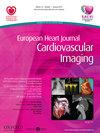Cardiac magnetic resonance derived global longitudinal strain outperforms established functional parameters in prognostication after ST-elevation myocardial infarction
引用次数: 0
Abstract
Type of funding sources: None. Although left ventricular ejection fraction (LVEF) is recommended for left ventricular (LV) systolic function assessment and risk stratification of patients with ST-elevation myocardial infarction (STEMI), its prognostic value is limited. Other measures of LV function such as global longitudinal strain (GLS) and mitral annular plane systolic excursion (MAPSE) might provide additional prognostic information post-STEMI. However, comprehensive investigations comparing these parameters in terms of prediction of hard clinical events following STEMI are lacking so far. We aimed to investigate the comparative prognostic value of LVEF, MAPSE and GLS by cardiac magnetic resonance (CMR) imaging in acute STEMI patients. This observational study included 407 consecutive acute STEMI patients treated with primary percutaneous coronary intervention (PCI). Comprehensive CMR investigations were performed 3 [interquartile range (IQR): 2-4] days after PCI to determine LVEF, GLS and MAPSE as well as myocardial infarct characteristics. Primary endpoint was the occurrence of MACE defined as composite of death, re-infarction and congestive heart failure. During a follow-up of 21 [IQR: 12-50] months, 40 (10%) patients experienced MACE. Patients with MACE showed significantly lower LVEF (49% vs. 53%, p = 0.005) and MAPSE (7.9 mm vs. 9.1 mm, p = 0.001), as well as higher GLS values (-10.2% vs. -12.3 %, p < 0.001). GLS showed the highest prognostic value with an area under the curve (AUC) of 0.71 (95% CI 0.63-0.79; p < 0.001) compared to MAPSE (AUC: 0.67, 95% CI 0.58-0.75; p = 0.001) and LVEF (AUC: 0.64, 95% CI 0.54-0.73; p = 0.005). After multivariable analysis, GLS emerged as independent predictor of MACE (HR: 1.22, 95% CI 1.11-1.35; p < 0.001). Of note, GLS remained associated with MACE (p < 0.001) even after adjustment for infarct size and microvascular obstruction. CMR-derived GLS emerged as strong and independent predictor of MACE after acute STEMI with additive prognostic validity to LVEF and parameters of myocardial damage.心脏磁共振衍生的整体纵向应变优于st段抬高心肌梗死后预后的既定功能参数
资金来源类型:无。虽然左室射血分数(LVEF)被推荐用于st段抬高型心肌梗死(STEMI)患者的左室(LV)收缩功能评估和风险分层,但其预后价值有限。其他左室功能的测量,如总纵向应变(GLS)和二尖瓣环平面收缩位移(MAPSE)可能提供stemi后的额外预后信息。然而,目前还缺乏比较这些参数预测STEMI后硬临床事件的综合研究。我们旨在探讨心脏磁共振(CMR)成像LVEF、MAPSE和GLS对急性STEMI患者预后的比较价值。这项观察性研究纳入了407例连续接受经皮冠状动脉介入治疗(PCI)的急性STEMI患者。PCI后3[四分位间距(IQR): 2-4]天进行全面CMR检查,以确定LVEF、GLS和MAPSE以及心肌梗死特征。主要终点是MACE的发生,MACE定义为死亡、再梗死和充血性心力衰竭的复合。随访21个月[IQR: 12-50], 40例(10%)患者出现MACE。MACE患者的LVEF (49% vs. 53%, p = 0.005)和MAPSE (7.9 mm vs. 9.1 mm, p = 0.001)显著降低,GLS值较高(-10.2% vs. - 12.3%, p < 0.001)。GLS表现出最高的预后价值,曲线下面积(AUC)为0.71 (95% CI 0.63-0.79;p < 0.001),与MAPSE相比(AUC: 0.67, 95% CI 0.58-0.75;p = 0.001)和LVEF (AUC: 0.64, 95% CI 0.54-0.73;p = 0.005)。多变量分析后,GLS成为MACE的独立预测因子(HR: 1.22, 95% CI 1.11-1.35;p < 0.001)。值得注意的是,即使在调整梗死面积和微血管阻塞后,GLS仍与MACE相关(p < 0.001)。cmr衍生的GLS是急性STEMI后MACE的强大且独立的预测因子,具有LVEF和心肌损伤参数的附加预后有效性。
本文章由计算机程序翻译,如有差异,请以英文原文为准。
求助全文
约1分钟内获得全文
求助全文

 求助内容:
求助内容: 应助结果提醒方式:
应助结果提醒方式:


